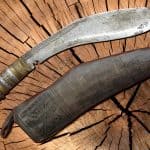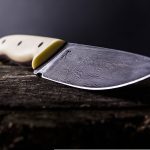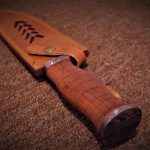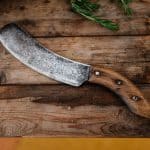
Introduction
Stropping is a method of knife sharpening that involves polishing and refining the sharpened edge of a knife rather than directly grinding it. This technique is sometimes referred to as refinishing or lapping, as it can help to repair minor damage to the blade’s edge, such as nicks or rolled edges. Stropping helps keep the steel molecules more compact, which leads to greater edge retention and sharper blades overall. The process is usually done with a leather strap impregnated with honing compound or diamond paste and is often preferred over traditional grinding-wheel systems because of its ease of use and affordability. The gentle nature of stropping also makes it suitable for taking extremely fine edges on knives that are already very sharp.
Not only does stropping offer numerous benefits to helping maintain sharpness and preserving knife edges, but it also helps reduce microscopic burrs from the base steel used in the manufacturing process, which can cause the edge to feel slightly rough when using the knife for cutting tasks. This roughness can be avoided by periodically stropping any kitchen knife regularly after each time it is used for chopping, dicing, slicing or other kitchen tasks. Stropping should be paired with traditional sharpening techniques such as honing and polishing in order to maintain peak levels of performance from your knives.
Gather the Necessary Tools and Materials
Stropping a knife is an easy and important skill for anyone to have, especially if you are going to be regularly maintaining or sharpening your knives. To do so, you need the following tools and materials: a leather strop, some stropping compound, a paper towel, and mild dish soap. You can also use other strops such as linen or canvas.
To begin stropping a knife, begin by cleaning it thoroughly with warm water and mild soapy solution. This will help ensure that all debris is removed from the blade in order to best prepare it for stropping. Once clean and dry, apply the stropping compound to one side of the leather strop. The compound should cover most of the surface but should not be too thick. Next, using smooth gentle movements pull the blade back over the leather strop on each side several times until there appears to be no more burrs. Finally, wipe off any residual compound with a damp paper towl and your knife should now be well sharpened!
Clean and Prepare the Strop
The first step in stropping a knife is to clean and prepare the strop. A strop is typically made from leather that has a special abrasive compound applied to it, such as polishing compounds or green chromium oxide. This will help sharpen the blade’s edge. Before use, ensure that the strop is secured firmly and make sure it is free of dust and debris since this can lead to premature wear or damage to the strop surface. For best results, use soapy water to clean the leather and then dry it before beginning.
Shaping the Edge
Once the strop has been prepared, you can start shaping the knife’s edge by drawing the knife across the surface of the strop with light pressure and a moderate speed. Continue repeating this motion on both sides until you achieve your desired outcome, usually in 5-10 strokes per side. Now you’re ready for honing your blade using finer strokes with more pressure on each side while applying slow but consistent strokes. Alternatively, if available, special jigs can be used to hold knives in place during stropping for precision honing.
Testing and Inspecting
Finally, it’s important to check your work after honing with a few tests such as cutting paper or running your fingers along the blade. If you are not satisfied with your blade sharpness after stropping, repeat steps two and three until you find satisfactory results. Moreover, regularly inspect your equipment for wear or scratches and replace them when needed as these can reduce their efficacy over time.
The Basics of Stropping a Knife
Stropping is a technique used to sharpen and polish knife blades. It involves passing the blade over a strop, a piece of material with an abrasive surface. Most often strops are made of leather that has been treated with abrasive compounds like diamond powder, chromium oxide, or aluminum oxide. Stropping can be done on any type of knife with an edge, from straight-edge kitchen knives to serrated outdoor knives..
For optimal results, stropping should be done following honing or sharpening the blade on a whetstone or other sharpening device. The abrasive agents in the strop will realign the edge of the blade while also adding shine and polish to create a smoother and sharper cutting surface. Different abrasives are used on different types of knife blades, depending on the desired result.
Before stropping, it is important to clean off any excess oil or dirt from the blade so it can make uniform contact with the strop. When ready to start stropping, secure one end of the strop in a stand or clamp; use your other hand to hold the knife firmly and draw it along the length of the strop while keeping even pressure and consistent strokes. Personal preference will dictate when you stop stropping – some people may find that 10-20 reps per side is sufficient for their needs while others may want more strokes for greater sharpness and longevity. Typically, lighter pressure is needed when working with harder materials such as ceramic or steel blades whereas softer materials like carbon steel require firmer pressure for added strength. With practice and patience anyone can learn how to effectively hone their own knives using this simple but effective format.
Different Stropping Techniques and How to Achieve the Best Results
Stropping a knife involves gradually sharpening the blade by stroking it with a firm, flexible surface such as a strop. This action removes burrs and imperfections from the blade, leaving it shaper than before. Depending on the desired outcome, different approaches and techniques can be applied while stropping a knife.
The most basic technique is that of straight-line stropping. This involves holding the strop still while running the blade along its length in one sweeping motion. The blade should lightly contact the entire length of the strop for an even result each time. The goal is to move smoothly with just enough speed to keep contact with the blade but not so fast that heat builds up from friction and dulls its edge.
Another technique is circular stropping which requires more skill since it is more challenging to perform uniformly than straight line stropping. The method involves keeping the strop in place and using small circles to bring the edge of the knife across all points on the surface. It is important that consistent pressure is applied throughout each circle so that all passes of a fixed diameter can achieve similar sharpening results in every part of their movement along the stone’s width.
Diamond paste or slurry can also be used while stropping to help abrade and shape an edge faster or repair chips or burrs more effectively than plain leather or canvas alone. The compound should be applied thinly and evenly over both sides of the strop, providing enough lubrication for consistent contact with the blade at all areas being worked on during each stroke, otherwise imperfections may not get removed completely or efficiently enough.
Finally, diamonds plates can be employed if you have one available; they reduce wear on your strop due to their explosive effectiveness at sharpening a hard material quickly when combined with coarse abrasive pastes like diamond sprays or polishing compounds respectively; however, care must taken when using them as improper use may lead to faster dulling rate for blades due to high cutting force generated by diamond particles embedded in plates’ surfaces exfoliating small pieces of steel off blades which for many expensive knives would otherwise remain intact through gentle stone grinding processes instead of diamond ripping them apart prematurely reducing their lifespan significantly..
Maintenance Tips for Keeping a Knife in Top Shape
Stropping a knife is the process of running either leather or synthetic material along the blade on both sides to create a fine, polished edge. Stropping can be done with any material which is supple enough to wrap around a piece of solid foam or cork. This activity should be done periodically if using the knife for cutting, depending on how much you use it. Before beginning this task, make sure that the blade has been properly sharpened and honed, as stropping will not sharpen a dull blade. When stropping a knife, hold it at about a 20-degree angle and lightly slide the blade backward along the strop twice on each side; however, avoid going in circles as this won’t produce an adequate edge. Once finished, wipe down the blades with oil or other protectants to prevent corrosion.
Common Stropping Pitfalls and Mistakes to Avoid
Stropping a knife is an easy and effective way to keep it sharp and well-maintained. However, there are several potential pitfalls and mistakes that should be avoided in order to ensure the best possible results.
One of the most common mistakes when stropping a knife is not having the correct angle or stroke. In order to achieve a sharpened blade, the blade needs to come into contact with the leather strop at an angle of focused consistent pressure during each successive pass over its surface. If it’s too low or high, the cutting edge won’t be as effective and could instead damage the edge by creating more dulling burrs.
Another mistake to avoid is applying too much pressure on the blade when stropping. It’s important to exert no more than moderate pressure, as too much can force grit from the leather onto the blades edge, thus negating its purpose while making current burrs even worse.
Finally, using an inappropriate type of stropping compound can lead to a poorly-sharpened edge if one isn’t careful. Different pastes and compounds provide different levels of abrasive grit which vary in its suitability for different knife uses; some put out enough abrasive material to be used on particularly hard steel while others are specifically meant for honing or perfecting relatively sharp blades such as kitchen knives or pocket knives. Check if your strop includes a suitable compound otherwise it’s better to invest in specialized stropping products specific for your knife’s desired use prior beginning any sharpening project.
Conclusion
The advantages of stropping a knife are clear. It is an easy, cost-effective way to sharpen and hone the blade, making it last longer and perform better. Not only does it allow you to sharpen the blade more quickly than other methods, but it can also achieve a finer, polished edge than is otherwise possible. Additionally, since there is no water involved when stropping a knife and no need for purchasing sharpening stones or expensive equipment, it makes regular maintenance simple and effortless.
However, there are also potential disadvantages that should be considered before engaging in this practice. For example, if too much pressure is applied or the process is repeated unnecessarily often, it could result in damage to the knife’s blade or even the handle itself. Furthermore, some experts suggest that certain knives with harder metals may benefit from additional sharpening techniques because they are not as efficient when they are merely stropped. Therefore, it’s important to consider the type of metal your knife contains before deciding which sharpening technique will provide you with the best results.
















